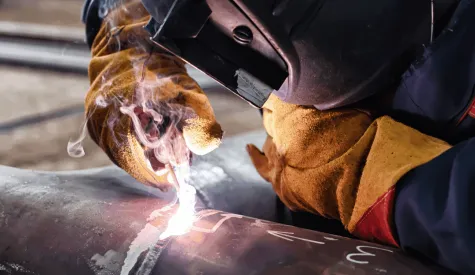Hand Injuries in Construction

A construction site can be a real epicenter for hand injuries. A 2011 article in EHS Today cites some scary statistics about the frequency and the expense of such incidents:
From the CDC -- Hand construction injuries send more than 1 million workers to the emergency room annually in the United States.
From the U.S. Bureau of Labor Statistics -- When cuts and lacerations of the fingers and hands are combined, the number of days-away-from work cases (approximately 110,000 annually), are second only to back strains and sprains,
From the National Safety Council -- The average direct cost of a laceration = $10,000; Stitches = $2,000 plus indirect costs, such as time away from work; Severed tendon = $70,000.
Lost time, costly expenses, and injured workers who can no longer do their job tasks — there are many reasons hand injuries are a real issue for the construction industry.
Step one to preventing these sorts of construction accidents begins with the right gloves for the job. For a 60% improvement in the relative risk for hand injury, be sure your construction workers have the correct gloves, that those gloves fit properly, and that they are actually worn. No slipping off the gloves “for just a moment so I can more easily finish this task.” Glove manufacturers use high-tech fibers and materials to make the outstanding PPE gloves available on the market today.
They are created with a focus on touch sensitivity and dexterity, which are key to a construction worker’s successful experience wearing gloves on the job. Gone are the days of clumsy, ill-fitting gloves that hinder tasks, so gloves should always be worn as appropriate for the task (while doing construction work) to prevent workplace injury or any fatal injury.
Good site safety training drives the point home about the seriousness of hand injuries, and emphasizes the importance of engineered safety devices like machine guards (and why we should never disable or bypass them), as well as the best practices to follow to help avoid injury.
Summit’s Hand Safety course includes information relevant for multiple facilities, including laboratories and manufacturing sites such as steel mills and automotive parts makers. Hand Safety covers:
- The importance of machine guards
- PPE and hand protection
- Ways to prevent hand injuries
- Available in Spanish
For a look specifically at laceration injuries, Summit offers Hand Safety: Lacerations, which addresses OSHA 29 CFR 1910.138. Lacerations can range in severity from a small cut to the amputation of fingers or the entire hand. To avoid these types of workplace injuries, this program covers:
- Engineering controls
- Personal protective equipment
- Safe work practices
- First aid procedures
For more construction occupational safety courses that will help protect your teams and keep you in compliance, check out the complete HSI catalog. Who knows, your construction workers’ safe hands might just give you a big round of applause.


